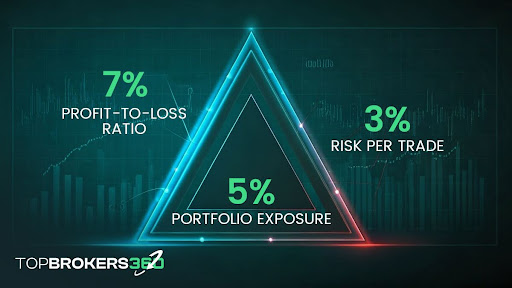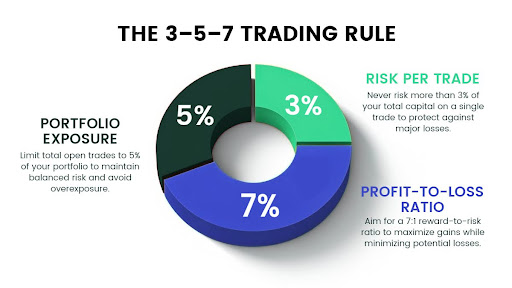The 3-5-7 rule is a widely-used risk management strategy that helps traders minimize their exposure to risk while optimizing the potential for profitability. Designed to provide a framework for balancing risk and reward, this rule is a tool that can be applied across various types of trading—from stocks to forex and even cryptocurrency.
At its core, the 3-5-7 rule encourages traders to limit their risk per trade, manage their overall exposure across multiple positions, and maintain a healthy profit-to-loss ratio. By sticking to this simple yet effective structure, traders can better navigate the ups and downs of the market without risking catastrophic losses.
The beauty of the 3-5-7 rule lies in its versatility. It can be easily adapted to fit different trading strategies and styles. Whether you’re a conservative trader looking for steady, sustainable growth or a more aggressive trader aiming to capitalize on larger market swings, the 3-5-7 rule offers a solid foundation for minimizing risk and ensuring that your winning trades are more profitable than your losing ones.
Understanding these rules is essential for traders, especially when choosing brokers that allow you to implement such strategies
In this guide, we’ll break down the essential components of the 3-5-7 rule, provide practical steps for implementation, and explore how it can be used effectively to improve your trading strategy.

Key Takeaways – Why the 3-5-7 Rule Works
Before diving into the details of the 3-5-7 rule, let’s take a look at the core principles behind it. By understanding these key takeaways, you’ll see why this rule is a game-changer for effective risk management and profitable trading.
1. Risk Management: Limiting Losses
The 3-5-7 rule is fundamentally about controlling risk to protect your capital. By limiting your risk to 3% per trade and 5% across all positions, you ensure that no single trade or series of trades can wipe out a significant portion of your account. This conservative approach gives you room to make mistakes while keeping your portfolio intact.
2. Profit Ratio: Favoring Winners Over Losers
Another essential element of the rule is maintaining a 7% profit-to-loss ratio. This means that your winning trades should, on average, be at least 7% larger than your losing ones. Even if you’re not right on every trade, this ratio ensures long-term profitability as your winners outweigh the losses.
3. Position Sizing: Calculating Your Risk
Position sizing is a crucial part of applying the 3-5-7 rule. By carefully calculating the size of each position based on your risk tolerance, you can ensure that you stay within the risk limits. This involves understanding your account size, the distance between your entry point and stop-loss, and adjusting the number of units accordingly.
4. Adaptability: Adjusting for Market Conditions
Markets are rarely static, and the 3-5-7 rule is designed to be adaptable. Depending on the market’s volatility and your trading style, you can adjust your risk percentage. In times of heightened volatility, you might lower your risk to 2% per trade, while in more stable conditions, you might slightly increase it—still ensuring your total exposure doesn’t exceed 5%.
Breaking Down the Numbers: The Mechanics of the 3-5-7 Rule
Now that we’ve covered the general idea of the 3-5-7 rule, let’s break down the specific numbers involved to better understand how they come together to form an effective trading strategy.

1. The 3% Rule: Managing Risk per Trade
The 3% rule is all about limiting the amount of risk you take on each individual trade. This number ensures that even a string of losses won’t have a devastating effect on your account balance. Let’s explore why this number is significant:
- Why 3%?: Limiting risk to 3% ensures that each loss is manageable. This risk level strikes a balance, providing enough room for potential profit while keeping losses within reason. A loss of 3% per trade doesn’t sound like much, but over a series of trades, it can add up—so maintaining this small percentage prevents a drastic impact on your overall account health.
- Calculating Your 3% Risk: To apply this rule, you first need to know your account size. For example, if your trading account has a balance of $10,000, your maximum risk per trade would be $300 (3% of $10,000). It doesn’t mean you are limited to trading $300 worth of assets, but rather, that your potential loss from a trade should not exceed $300.
- Position Sizing and Stop Losses: Position sizing directly correlates with the 3% rule. When setting your stop-loss order, the distance between your entry point and stop-loss level determines how many units you can trade without exceeding your risk threshold. For instance, if your stop-loss is set at $1 away from your entry point, you could purchase 300 shares. If the stop-loss is only $0.50 away, you can buy 600 shares, keeping within the 3% limit.
2. The 5% Rule: Safeguarding Your Portfolio
While the 3% rule protects each trade individually, the 5% rule governs your entire portfolio’s exposure. This ensures you don’t overexpose yourself to risk by having too many open positions at the same time.
- Why 5%?: The goal here is to prevent a scenario where multiple trades, even though each is limited to 3% risk, could collectively cause significant damage to your account. By keeping your total risk exposure to no more than 5% of your entire account, you ensure that you don’t end up putting yourself in a situation where your portfolio is too vulnerable.
- Practical Example: If your account size is $10,000, your total portfolio risk across all open positions should not exceed $500 (5% of $10,000). You could have multiple trades open, but the total amount at risk from all trades combined shouldn’t surpass this threshold. This helps you manage overall exposure to ensure no single bad streak wipes out your gains.
- Dynamic Risk Management: The beauty of the 5% rule is its flexibility. If your account grows to $12,000, for instance, your total risk allowance increases to $600. Conversely, if you suffer a loss and your account shrinks to $8,000, your total risk limit would drop to $400, forcing you to become more selective in your trades.
3. The 7% Rule: Profit-to-Loss Ratio for Long-Term Success
The final piece of the 3-5-7 puzzle is the 7% profit-to-loss ratio. This ensures that your winning trades are proportionately larger than your losing ones, contributing to long-term profitability.
- Why 7%?: By requiring your average winners to be at least 7% larger than your average losses, the 7% rule ensures that even if you have more losing trades than winning ones, your profits will outpace your losses. This ratio turns your trading strategy into a winning one over time.
- Practical Calculation: If your average loss is $300, your average win should be $321 (7% more than the loss). While the difference may seem small, this compounded over many trades can have a significant impact on your account balance. It’s the key to converting a string of losses into long-term profitability.
Psychological Advantage: The 7% rule also plays a role in shaping the psychology of trading. It encourages patience with profitable trades and quick exits from losing ones. This balance between risk and reward helps traders avoid the emotional pitfalls that lead to prematurely cutting winners short or holding onto losers too long.
Implementing the 3-5-7 Rule in Your Trading Strategy
Now that we understand the individual components of the 3-5-7 rule, let’s focus on how to practically implement this strategy in your trading routine. The process is all about discipline, consistency, and making necessary adjustments to suit market conditions. For a well-rounded strategy, also consider how using the best brokers and forums for discussion can enhance your approach
Here’s a step-by-step guide to help you incorporate the 3-5-7 rule into your trading:
Step 1: Assess Your Current Trading Strategy
Before diving into the 3-5-7 rule, it’s essential to evaluate your existing approach. This self-assessment will help you identify areas where the rule can be effectively applied and where adjustments might be needed.
- Questions to ask yourself:
- Are you currently risking more than 3% per trade?
- Does your overall portfolio risk exceed the 5% threshold?
- How does your win-to-loss ratio compare? Are your wins larger than your losses?
- Honest self-assessment: It’s vital to be honest about where you stand. This will help you fine-tune your strategy and adapt the 3-5-7 rule to your personal trading style.
Step 2: Adjust Your Position Sizing
One of the most challenging aspects of the 3-5-7 rule is adjusting your position sizes to align with the 3% per trade risk limit. However, this is crucial for the longevity of your trading career.
- Position sizing: You may need to reduce your trade sizes to stay within the 3% risk limit. This could feel uncomfortable at first, especially if you’re used to larger positions, but remember: it’s about protecting your capital over the long term, not making quick profits.
- Calculating position sizes: To determine the size of a trade, you need to assess your stop-loss distance and account balance. If your stop-loss is wide, you’ll need to reduce your position size to maintain the 3% risk per trade.
Step 3: Set Clear Stop-Losses
The stop-loss is your first line of defense against large losses, and it’s the key to ensuring that the 3% rule remains effective.
- Discipline: Set a stop-loss level that ensures your potential loss stays within the 3% risk limit. Stick to it, even if the market moves against you. Being disciplined about stop-loss placement is vital for long-term success.
- Adjusting stop-loss levels: If you’re trading volatile assets or in unpredictable markets, it might be necessary to adjust your stop-loss levels to avoid premature exits. For instance, use Average True Range (ATR) to calculate stop-loss placements that account for market volatility.
Step 4: Monitor Your Overall Portfolio Exposure
At any given time, it’s essential to keep track of your total portfolio risk. This means monitoring your open positions and ensuring that the total risk does not exceed the 5% portfolio limit.
- Real-time monitoring: Use a risk management tool or spreadsheet to track your open trades and the risk associated with each. Be ready to pass on new opportunities if your portfolio’s risk exposure is already too high.
- Diversification: To manage overall exposure, ensure that your portfolio is diversified. Having too many correlated positions—such as stocks from the same sector—could increase your risk, even if each individual trade is limited to 3%.
Step 5: Analyze Your Winners and Losers
Consistent performance analysis is critical to ensuring that your trades follow the 7% profit-to-loss ratio.
- Review your trades: After each trade (win or loss), analyze the outcome to assess if your winners are consistently larger than your losers. If your average win is smaller than your average loss, you may need to adjust your exit strategy or take profit targets.
- Optimize your strategy: If you’re not hitting the 7% profit-to-loss target, consider tweaking your strategy. Perhaps you’re exiting trades too early or setting your profit targets too low. Regular review and adjustments will help you fine-tune your approach for better profitability.
Advanced Applications of the 3-5-7 Rule
While the 3-5-7 rule is a solid foundation for risk management, its true potential shines when applied with advanced trading techniques. Here’s how you can take the basic framework and apply it to more nuanced, complex strategies:
Scaling In and Out of Positions
One of the key benefits of the 3-5-7 rule is that it doesn’t prohibit you from scaling into or out of positions. This means you can adjust your exposure to a trade depending on how it’s performing, while still adhering to the overall risk limits.
- Scaling in: If your initial trade is doing well and you’re confident about the direction of the market, you can increase your position size gradually. However, keep your overall risk exposure in check. If you start with a 1% risk, you might choose to add another 1% or 2% as the trade progresses in your favor. Just ensure that the total risk across all trades stays within the 5% portfolio risk limit.
- Scaling out: Similarly, if a trade is performing well, you can scale out of the position by selling a portion of your holdings. This allows you to lock in profits while still leaving some exposure to potential further gains.
Adapting to Market Conditions
The 3-5-7 rule can be adapted depending on the market environment. In periods of high volatility, it might be necessary to reduce your per-trade risk, while in calm market conditions, you could afford slightly higher risk.
- High Volatility: In volatile markets, consider lowering your per-trade risk to 2% or even 1%. Volatile markets often lead to wider stop-losses and increased uncertainty, so it’s essential to adjust accordingly. In these times, staying below the 3% risk per trade ensures that you don’t get caught in major drawdowns.
- Calm Markets: In more stable market conditions, you might find it comfortable to slightly increase your risk per trade, perhaps to 4%. However, always remember the total portfolio risk should still stay below the 5% mark.
Combining with Other Trading Strategies
The 3-5-7 rule doesn’t need to exist in a vacuum—it can be integrated with other trading strategies. Whether you’re a trend follower, reversal trader, or scalper, you can combine it with your preferred trading approach to enhance your overall risk management.
- Trend Following: If you’re trading in the direction of the prevailing trend, you might want to use larger stop-losses to avoid getting stopped out prematurely. The 3-5-7 rule will help you stay within risk limits while you ride the trend.
- Scalping: For scalpers, the 3-5-7 rule can help you maintain discipline when dealing with tight stop-losses and frequent trades. By adhering to position size restrictions and profit-to-loss ratios, you ensure that your risk management stays strong even in fast-paced markets.
- Reversal Trading: In reversal strategies, where you bet on price turning around, it’s important to be cautious. The 3-5-7 rule will help you manage risk while waiting for the right entry points. Keep your risk levels low until the market confirms the reversal.
Common Mistakes and How to Avoid Them
Despite the straightforward nature of the 3-5-7 rule, traders often fall into certain traps that can undermine the effectiveness of the strategy. Let’s explore some of the most common mistakes traders make and how you can avoid them to maximize your success.

Mistake 1: Ignoring the Rules in Excitement
It’s easy to break the rules when you feel certain you’ve found a “can’t-miss” trade. The excitement of a promising opportunity can cloud your judgment, but ignoring the 3-5-7 rule in these moments can lead to disastrous results. The key is to remember that no trade is worth jeopardizing your entire account.
How to Avoid It: Stick to your risk limits, even when tempted by high-conviction trades. If you think the trade is worth the risk, you can adjust your position size to stay within the rule’s boundaries. Trading with discipline is essential to long-term success.
Mistake 2: Not Adjusting for Volatility
The 3% rule assumes a certain market environment, but it doesn’t account for the fact that market volatility can vary greatly. In highly volatile markets, your 3% risk may not be enough to avoid getting stopped out due to large price swings. Conversely, in calm markets, it could be too much risk for smaller movements.
How to Avoid It: Adjust your risk per trade depending on market conditions. Use technical indicators like Average True Range (ATR) to gauge volatility and adapt your position size accordingly. Reducing risk in volatile conditions can help you avoid premature stop-outs and prevent unnecessary losses.
Mistake 3: Forgetting About Correlation
Many traders overlook the correlation between their open positions. If you have multiple trades that are highly correlated—such as two trades in the same sector or two stocks that are strongly linked—your risk could be much higher than you initially calculated. This is especially true if the market moves in the same direction for both trades, leading to compounded losses.
How to Avoid It: Always consider the relationships between your open positions. Diversifying your portfolio by including uncorrelated assets can reduce overall risk. Tools like correlation matrices or even basic sector analysis can help you understand the risks associated with correlated trades.
Mistake 4: Overlooking Commission Costs
Many traders focus purely on price movement and fail to factor in the costs associated with trading, such as commission fees, spreads, and slippage. These costs can eat into your profits and skew your risk-to-reward calculations. For day traders or frequent traders, these costs can accumulate quickly.
How to Avoid It: Always incorporate commissions, spreads, and slippage into your calculations. Make sure your risk-to-reward ratio is adjusted to account for these hidden costs. If you’re trading frequently, look for brokers with low commissions and tight spreads to minimize the impact on your profitability.
The Long-Term Impact of the 3-5-7 Rule
The 3-5-7 rule isn’t just a short-term trading strategy—it’s designed to be a long-term approach to risk management and profitability. By consistently applying the principles outlined in this rule, traders can achieve sustainable growth and develop a mindset that is resilient to the emotional ups and downs of the market.
Consistency Over Time
The real power of the 3-5-7 rule reveals itself over the long haul. While individual trades may produce mixed results, consistently adhering to the rule over hundreds or thousands of trades can lead to compounded profits. It’s not about hitting home runs on every trade, but about making steady progress toward growth over time.
How It Works: By keeping risk limited and ensuring that winners outpace losers by a reasonable margin, traders can experience cumulative gains over time. Even if your win rate isn’t extraordinarily high, the law of averages and the power of a well-maintained risk-to-reward ratio will work in your favor.
Psychological Resilience
One of the often-overlooked benefits of the 3-5-7 rule is its ability to enhance your psychological resilience as a trader. Risk management isn’t just about protecting your capital—it’s also about protecting your mindset. The rule forces you to accept and embrace losses as part of the process, reducing the emotional toll that often accompanies losing trades.
How It Works: When you strictly adhere to the 3% risk per trade, you know that a loss is just a temporary setback rather than a catastrophic event. This allows you to stay calm, keep perspective, and stick to your strategy, even during a losing streak.
Compounding Effects
As your account grows, so do the absolute values of your 3% and 5% risk limits. This allows for larger positions and the potential for greater profits—all while maintaining the same relative risk. The beauty of compounding in trading is that it works in your favor as you continue to follow the same risk management rules.
How It Works: Let’s say you start with a $10,000 account. By applying the 3% risk rule, you risk $300 per trade. If your account grows to $20,000, you can now risk $600 per trade, still staying within the same relative risk. This ability to scale up your positions while maintaining risk management is one of the primary advantages of the 3-5-7 rule over time.
Conclusion
The 3-5-7 rule is a powerful risk management strategy that provides traders with a clear framework to protect their capital while aiming for consistent profitability. By limiting risk to 3% per trade, controlling total exposure across all positions at 5%, and targeting a minimum 7% profit-to-loss ratio, the rule helps create a balanced approach to trading that can withstand the inherent volatility of the markets.
While no strategy is foolproof, the 3-5-7 rule offers traders a disciplined, systematic approach to trading that minimizes the risk of catastrophic losses. It forces traders to think critically about position sizing, stop loss placement, and overall exposure, which can lead to more thoughtful and strategic decisions in the long run.
If you’re a novice trader, the 3-5-7 rule provides a solid foundation for building your trading strategy. For experienced traders, it serves as a useful tool for refining your risk management practices and ensuring that you’re not risking more than you can afford to lose.
Ultimately, the 3-5-7 rule is about maintaining discipline, embracing long-term growth, and protecting your capital. By staying committed to this risk management approach, you can reduce emotional stress, avoid significant losses, and set yourself up for sustainable success in the markets.
